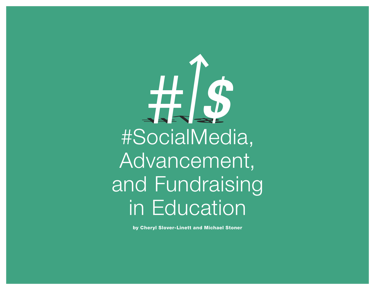Just Released: White Paper on Social Media, Advancement & Fundraising in Higher Ed
Oct 22, 2013
A new white paper on social media use in institutional advancement shows that a growing number of schools, colleges, and universities around the world are using Facebook, Twitter, and other social networks to raise money, steward donors, and connect with their community. [Note: we shared some results from this research and a presentation of highlights earlier this year.]
#Social Media, Advancement, and Fundraising in Education reports on findings from the fourth survey of social media in advancement, conducted earlier this year by Huron Education and mStoner in partnership with the Council for Advancement and Support of Education [CASE]. More than 1,000 respondents provided feedback on the tools they are using, how they use them, challenges they face, and what they expect as return on investment. Cheryl Slover-Linett, a consultant to Huron, and I wrote the text of the white paper.
Among the notable findings is evidence of the growing use of social media in campaigns of all kinds — from alumni engagement and institutional branding to fundraising and admissions. For example, 54 percent of respondents said they have used social media in a campaign, and 29 percent of those said that they use social channels in three-quarters or more of their campaigns. [Here are the top-line findings from the survey.]
The white paper includes six case studies about the successful use of social media in recent fundraising campaigns. Gareth Henderson and Justin Ware contributed the case studies. [Justin writes a terrific blog about social media and philanthropy.] Among the highlights:
- Columbia University in New York City used an integrated marketing campaign — including social media — to raise $6.8 million in a one-day event.
- Phillips Exeter Academy in New Hampshire used social media to encourage donations during its Big Red Dorm Challenge, an annual, weeklong, fundraising competition among alumni and current students with dorm affiliations. The institution received 275 gifts from the classes of 1970–2012 and 192 from the current senior class.
- The Indiana University Alumni Association used social media during the men’s basketball season to attract new members. It gained 233 new members, bringing in more than $26,000 in revenue.
- The University of Massachusetts Amherst used social media during a campaign to engage more student donors. During a 36-hour campaign, 626 current students made a gift to the institution. In all of the year prior, 529 students made a gift.
- Skidmore College in Saratoga Springs, NY, used social media during a 24-hour campaign to increase the number of donors to the college’s annual fund by attracting more young donors. The campaign garnered more than 1,000 gifts, 59 percent of which came from donors who had graduated within the last decade.
- Georgetown University in Washington, DC, used social media during a 24-hour challenge, pitting alumni from seven different cities against one another to see who could encourage the most donors to give. It raised $529,000. In addition, 898 of the 1,514 donors gave for the first time that year.
For a complete look at the data and differences between groups, see these appendices:
- The Survey Data by Institution Type, which addresses size, public compared to private, geography (North America compared to abroad), and K‑12 compared to higher education institutions.
- The Survey Data by Key Uses of Social Media appendix shows groupings by those who rate their units “very successful” or a “model for successful use of social media” compared to those who rate themselves as less successful, units that handle their own social media compared to those that are less directly involved with social media, and institutions that use social media in fundraising compared to those that do not.
-
Michael Stoner Co-Founder and Co-Owner Was I born a skeptic or did I become one as I watched the hypestorm gather during the dotcom years, recede, and congeal once more as we come to terms with our online, social, mobile world? Whatever. I'm not much interested in cutting edge but what actually works for real people in the real world. Does that make me a bad person?
